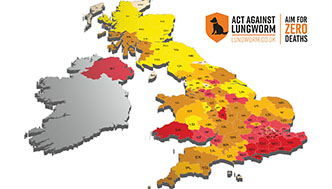Everything you should know about lungworm in dogs
As dog owners, we cherish our furry companions and want to keep them safe. While many of us are familiar with common parasites like fleas and ticks, there's a growing threat that often goes unnoticed until it's too late: lungworm (Angiostrongylus vasorum).
This parasite is becoming more widespread across the UK, and vets are urging owners to be vigilant. Understanding lungworm, how it spreads, and how to prevent it is crucial for your dog's health.
What is lungworm and why is it a growing concern?
Unlike common intestinal worms, lungworm doesn't live in your dog's gut. Instead, it makes its home in the heart and the major blood vessels that supply the lungs. This can lead to serious, life-threatening health problems, including breathing difficulties, bleeding disorders, and even neurological issues. Many dog owners, tragically, only learn about lungworm after their beloved pet has become seriously ill or passed away.

The parasite's spread across the UK is a significant concern, with reports of cases in areas previously thought to be low-risk. This means vigilance is more important than ever, no matter where you live.
How do dogs get lungworm?
The way dogs pick up lungworm is often surprising to owners. The parasite has a specific life cycle that involves slugs and snails:
1. Infected poop
An infected dog passes tiny lungworm larvae (baby worms) in their faeces.
2. Slug & snail connection:
The larvae are eaten by slugs and snails then develop into an infective stage. Your dog becomes infected by accidentally eating an infected slug or snail.
3. Migration of the larvae:
Once the larvae are inside the dog, they migrate out of the intestines to the heart, then develop into adult worms in the artery that goes from the heart to the lungs. The adult worms lay eggs in the lungs, which hatch into new larvae. These larvae are coughed up, swallowed, and then passed in the faeces.
The role of foxes in the spread of lungworm
Foxes are significant carriers of lungworm. They can become infected and then spread the larvae through their faeces, contaminating environments like gardens, parks, and fields. This means even if your dog doesn't directly encounter slugs or snails, they could still be at risk from contaminated areas where foxes have been.

What are the signs of lungworm in dogs?
One of the biggest challenges with lungworm is that its symptoms can be varied, subtle, and often mimic other common illnesses. However, as lungworm can prove fatal if the condition is not diagnosed and treated, knowing what to look for can be life saving: the earlier lungworm is diagnosed and treated, the more likely your dog will recover.
Be vigilant for any of these signs:

Changes in behaviour
Changes in behaviour can be hard to pin down but a dog with lungworm is likely to tire easily, even after gentle exercise. Fatigue could be one of the first physical changes you notice – especially in young, usually lively dogs. if your dog is noticeably lethargic or depressed, or suffers from seizures, you should always contact your vet immediately.
Breathing difficulties
A persistent cough is one of the more common lungworm symptoms, triggered by the presence of worms in the dog’s lungs. They may even lead pets to cough up blood. A cough like this should never be ignored or confused with more common respiratory infections, like kennel cough.
Poor blood clotting
If your dog bleeds persistently from a minor wound, it could be a sign they’ve contracted lungworm. Lungworm can lead to poor blood clotting, which can also make your dog more prone to nose bleeds, and can cause anaemia, which may make your dog’s eyes and gums look paler than usual. Lungworm may also cause bleeding in the whites of the eyes.
Your dog may experience other problems with bleeding too, including:
- bloody stools
- passing blood when weeing
- vomiting blood
General sickness
Lungworm can be associated with vomiting and diarrhoea but this is not always the case. The problem is that these signs are also the symptoms of many other common or temporary health problems – including food allergies and tummy upsets.
If your dog has contracted lungworm, they may also have other non-specific signs such as weight loss or poor appetite. Lungworm can be present in your dog’s body for months without any obvious symptoms, and the signs are easily confused with other illnesses, which makes diagnosis tricky.
If you notice any of these symptoms, especially a combination, contact your vet immediately. Don't wait, as early diagnosis significantly improves the chances of a positive outcome.
How does a vet diagnose lungworm in dogs?
If your vet suspects lungworm, they will likely perform tests. This can include:
- Faecal examination: The most common way to confirm a lungworm infection is to test the dog’s faeces for lungworm larvae. However, this isn’t always straight-forward because it can take more than a month for the parasite to show up in the dog’s stools, so multiple tests may be required..
- Blood Tests: Specific tests can detect the presence of lungworm antigens.
- Imaging: X-rays of the chest might show changes in the lungs.
If diagnosed, lungworm can be treated with specific medications prescribed by your vet. The earlier the treatment begins, the better the prognosis.
How can you prevent lungworm in your dog?
Prevention is truly the best defence against lungworm. Here are the key steps every dog owner should take:
- Preventative products
Discuss appropriate preventative products with your vet as not all routine worming treatments are effective against lungworm
 Scoop the poop!
Scoop the poop!Always pick up your dog's faeces promptly and dispose of it responsibly, to help break the lungworm life cycle
 Environmental control
Environmental controlDiscourage your dog from eating slugs and snails when they're on their adventures
What to do if lungworm is reported in your area
If you hear that lungworm cases have been confirmed in your vicinity, it's a clear signal to re-evaluate prevention by ensuring your dog is on a consistent, vet-prescribed lungworm preventative. If not, contact your vet right away. At the same time, increase vigilance of your dog's behaviour and any potential symptoms and be diligent about picking up faeces.
By taking these proactive steps, you can significantly reduce your dog's risk of contracting this serious parasite. Your vet is your best partner in protecting your dog from lungworm.

